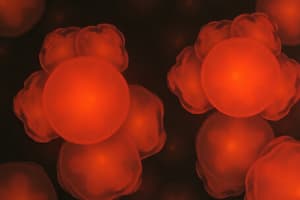Podcast
Questions and Answers
What percentage of circulating leukocytes do neutrophils constitute?
What percentage of circulating leukocytes do neutrophils constitute?
- 40-50%
- 50-60%
- 30-40%
- 60-70% (correct)
What is the primary function of neutrophils?
What is the primary function of neutrophils?
- To ingest and destroy invading organisms (correct)
- To regulate blood pressure
- To produce histamine
- To produce antibodies
What is characteristic of eosinophils?
What is characteristic of eosinophils?
- A bilobed nucleus and small granules
- A multilobed nucleus and small granules
- A bilobed nucleus and large, elongated granules (correct)
- A spherical nucleus and large granules
What is a major function of eosinophils?
What is a major function of eosinophils?
What is characteristic of basophils?
What is characteristic of basophils?
What percentage of WBCs are basophils?
What percentage of WBCs are basophils?
What is a characteristic of lymphocytes?
What is a characteristic of lymphocytes?
What percentage of WBCs are lymphocytes?
What percentage of WBCs are lymphocytes?
What is the primary function of plasma cells in the body?
What is the primary function of plasma cells in the body?
What percentage of white blood cells are monocytes?
What percentage of white blood cells are monocytes?
What is the shape of the nucleus in monocytes?
What is the shape of the nucleus in monocytes?
Where can plasma cells be found in a healthy individual?
Where can plasma cells be found in a healthy individual?
What is the lifespan of monocytes in the blood?
What is the lifespan of monocytes in the blood?
What is the function of monocytes in the connective tissue?
What is the function of monocytes in the connective tissue?
Flashcards are hidden until you start studying
Study Notes
Neutrophils
- Constitute 60-70% of circulating leukocytes
- Nucleus consists of 2-5 lobes linked by fine chromatin thread
- Cytoplasm contains small specific granules
- Circulate in blood in resting state, but can become motile and phagocytic in tissues
- Primary function is to ingest and destroy invading organisms
- Die after performing their function, resulting in pus formation
Eosinophils
- Constitute 2-4% of total WBC count
- Have a characteristic bilobed nucleus
- Presence of many large and elongated granules that are stained by eosin
- Increase in number in parasitic infestations and allergic states
- Play a major role in protecting against parasitic diseases
Basophils
- Constitute less than 1% of total WBC count
- Nucleus is divided into irregular lobes
- Cytoplasmic granules are large, intensely basophilic, and irregular in size and shape
- Contain histamine (vasodilator) and heparin (anticoagulant)
- May be precursors of tissue mast cells
Lymphocytes
- Constitute 20-25% of WBCs
- Have an ovoid nucleus and scanty cytoplasm
- Two main types: T lymphocytes and B lymphocytes
- Responsible for immune surveillance and detecting foreign particles in tissues
- B lymphocytes can differentiate into plasma cells after immune response
- Plasma cells are responsible for active synthesis of immunoglobulins
Monocytes
- Are the largest of the leukocytes
- Constitute 3-8% of WBCs
- Have an oval or kidney-shaped nucleus and basophilic cytoplasm
- Can live in blood for 8 hours, then move into connective tissue
- Precursor cells of tissue macrophages and other cells of the mononuclear phagocytic system
Studying That Suits You
Use AI to generate personalized quizzes and flashcards to suit your learning preferences.



